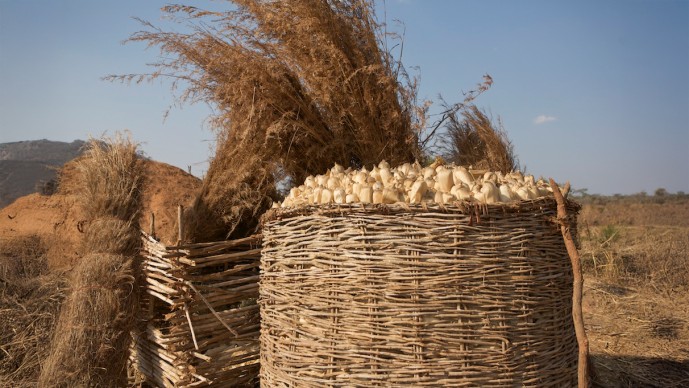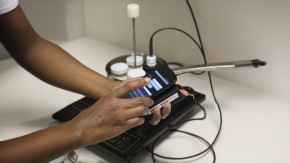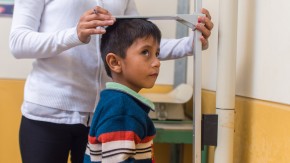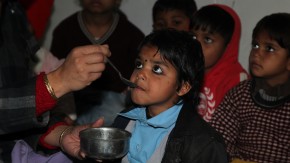
Unless you live there, the odds that the last tomato you ate was grown by a smallholder farmer in Burkina Faso are zero. In fact, the odds are that you're buying most of your produce - tomatoes, lemons, all of it - from one of a few huge, multinational companies. That's because these companies can afford to use what's called the cold chain, a vast, continent-spanning system of refrigeration that keeps your tomato fresh four times longer. That's long enough for it to make the trip from the field, where it starts, to the shelf at your local grocery store. The smallholder farmer in Burkina Faso, on the other hand, has no access to the cold chain, so she has to sell her tomato locally, and she has to sell it right away, before it starts to go bad, for whatever price the local market offers.
Unless Dr. James Rogers, a materials scientist and founder and CEO of Apeel Sciences, has his way, that is.
When he read the Grand Challenges Explorations (GCE) call for proposals to protect crops from field to market in 2012, he started thinking about lemons and tomatoes - specifically, about the difference between the time it takes each fruit to go bad. For the lemon, it's about a month. The tomato, on the other hand, only gets a week. It didn't take him long to begin to suspect that the difference had something to do with the difference between the two fruits' peels. So he started looking closer, to see what the peels were made of, and what he discovered, to his surprise, was that they were made of exactly the same thing; the same molecules were just arranged differently in the lemon peel and the tomato peel. Once he realized that, he started scribbling on a napkin.
Dr. Rogers, by the way, didn't start out in agriculture; he'd studied material science, starting with an undergraduate degree at Carnegie Mellon in Pittsburgh. Since Pittsburgh is a steel town, he and his classmates had worked with a lot of steel, and he knew what made stainless steel special: the elements like chromium and nickel that, mixed in, reacted to form a barrier that kept oxygen from reaching the surface of the steel. That wasn't too different, he reasoned, from how a lemon peel keeps oxygen from reaching the surface of the fruit, while at the same time it keeps water inside.
He came to us with his scribbled napkin - OK, actually the standard, two-page GCE proposal - and left with a grant. Over the next two years, he worked in his garage to develop a water-and-vegetable based liquid he could dip fruit and vegetables into that would give them an extra peel one molecule thick - a peel that couldn't be seen, smelled, or tasted. That peel would have the same molecules as a lemon peel and a tomato peel, but arranged in a way that kept them from going bad much longer. Dip a tomato in the liquid, and it would, in essence, gain an undetectable lemon peel - one that keeps it as fresh a month after you've brought it home as it was on the day you bought it. Dip a lemon in a slightly different formulation of the liquid, and it would grow an even lemon-peel-ier lemon peel.
With his proof of concept, he won a follow-on grant to refine the coating, optimize it for cassava, and turn it into a powder that small farmers in poor countries could easily mix with water to extend the shelf life of their crops. The small farmers he worked with were thrilled.
Since then, Rogers and his team have refined the powder so that it can be used for dozens of different fruits and vegetables: not just lemons and tomatoes, but also blueberries, asparagus, strawberries, peppers - you name it (and you can see an amazing time-lapse video of treated and untreated fruit at the Apeel Sciences website). Apeel has also attracted $110 million in investor capital, and the product has already saved more than 1 million avocados from waste since its market introduction in 2018, with retailers like Costco and Kroger. I'm writing this in late 2019; by the end of this year, those food-waste fighting avocados will be in every Kroger in the country.
But for Rogers, the exciting part is what happens next: if the coating he's developed wins approval from the international regulatory associations, which he expects will happen later this year, then small farmers in poor countries can start using it to extend the shelf life of their crops - the first step towards expanding their market by billions of people.
If everything goes as Dr. Rogers hopes it will, then in a decade the world's food systems will be a lot more participatory. Or, in practical terms, you'll be able to head to the corner store and buy a tomato produced by a small farmer in Burkina Faso. That will be good for you, certainly, but it could be life-changing for the small farmer in Burkina Faso - and for hundreds of millions of others like her around the world.



